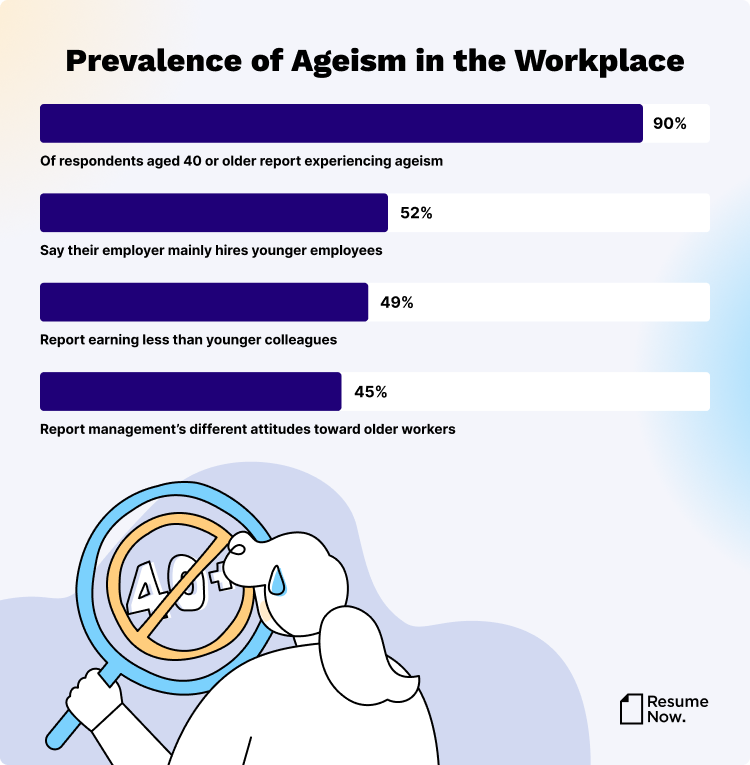Ageism often goes unmentioned in discussions about workplace equality. However, for workers aged 40 or older, being judged by their age rather than their abilities is a common experience. Despite the wealth of knowledge and experience older employees bring to their jobs, many still face significant challenges, from workplace discrimination to pay disparities.
To learn more about ageism in the workplace, Resume Now polled 1,003 U.S.-based workers aged 40 or older for its 2024 State of Ageism in the Workplace Survey, which examined the prevalence and impact of age-related discrimination.
The survey, which delved into how ageism manifests in hiring practices, pay disparities, and workplace dynamics, found that 90% of respondents have experienced ageism in the workplace. Often, these experiences have resulted in negative emotional and financial outcomes for workers. Of those polled, 49% of older workers report earning less than their younger colleagues and 44% report depression as a result of ageism.
Let’s take a deep dive into the survey data to learn more.
Widespread Presence of Ageism in the Workplace
While 90% of survey respondents have experienced ageism in the workplace, age-related bias is a broad umbrella that can manifest in many different ways. When surveyed, the respondents reported the top forms age discrimination can take include:
- 52% – An employer that mainly hires younger employees
- 49% – Earning less money than younger colleagues who do the same job
- 45% – Different attitudes of management or leadership toward older workers than younger employees
- 35% – A work environment where colleagues and/or managers make age-related comments
- 22% – A work environment where older workers are passed over for challenging assignments
- 21% – An employer that claims individuals over a certain age are “overqualified” for some jobs
- 16% – An employer that excludes older employees from certain activities, such as meetings or activities
- 16% – An employer that engages in a pattern of passing over older workers for promotions in favor of younger workers with fewer qualifications
These forms of discrimination are hard to prove or police, but they reflect the deep-rooted biases that continue to marginalize Gen X and Baby Boomers in the workplace.
Respondents have also faced more egregious forms of age discrimination, though in smaller numbers. These include:
- 11% – An employer that physically isolates older workers (for example, the location of their offices or workstations) as a means of excluding them from participating
- 11% – Facing unfair discipline due to age-related physical challenges
- 11% – Layoffs that focus primarily on older workers
- 10% – Facing unfair discipline due to age-related cognitive challenges
The Financial Toll of Ageism
Ageism significantly affects the financial stability of older workers, impacting their earnings and retirement plans. When asked how ageism has jeopardized their financial security and long-term retirement plans:
- 48% reported lower earning potential due to age-related discrimination
- 43% experienced early or forced retirement
- 50% adjusted their plans to retire earlier than expected
- 34% delayed their retirement
- 94% stated that ageism limits their access to professional development and training opportunities
The Emotional and Health Toll of Ageism
The emotional and mental health impacts of ageism are profound, leading to feelings of isolation and an overall negative effect on a person’s well-being:
- 45% experienced isolation and loneliness
- 44% reported depression
- 36% experienced anxiety
- 25% stated it caused them to engage in unhealthy habits, like eating a poor diet, smoking, or drinking
- 20% reported it negatively impacted their confidence and self-worth
HR's Role in Ageism
Survey respondents reported taking appropriate measures to deal with the age bias they experienced, with 94% stating they reported workplace age discrimination to HR. In most cases, HR took steps to handle the issue:
- 45% said HR mediated the situation
- 45% reported that HR initiated disciplinary action against the perpetrator
- 10% stated that HR did nothing to intervene
When HR took disciplinary action, the consequences for perpetrators of ageism tended to be relatively mild. Here’s how respondents report HR handled these issues:
- 37% of respondents noted that the perpetrator was given a warning
- 30% said the individual was disciplined but not fired
- 23% stated that the person or people they reported were fired
- 5% said HR took no action
Workers’ attempts to remediate and address the negative impact of ageism in the workplace were so challenging that 91% of respondents considered taking legal action. This high percentage indicates that existing workplace measures may not be sufficient to address the pervasive issue of ageism.
For media inquiries, contact Joseph Santaella, public relations specialist, at joseph@resume-now.com.
Methodology:
The findings provided were gathered through a survey conducted with 1,003 American respondents on May 6, 2024. Participants were queried about ageism in the workplace, responding to various question types, including yes/no questions, open-ended questions, scale-based questions gauging agreement levels, and questions that permitted the selection of multiple options from a list of answers.
About Resume Now
Resume Now is a powerful resource dedicated to helping job-seekers achieve their potential. Resume-Now’s AI resume builder is a cutting-edge tool that makes creating a resume fast, easy, and painless. Resume Now has been dedicated to serving job seekers since 2005. Alongside its powerful AI resume builder and stylish, ready-to-use templates, it also features free advice for job seekers at every career stage, guides for every step of the hiring process, and free resources for writing cover letters. Resume-Now is committed to supporting job seekers and workers alike and has conducted numerous surveys related to the experience, trends, and culture of the workplace. These surveys have been featured in Business Insider, CNBC, Fast Company, Yahoo!, Forbes, and more. Keep up with Resume-Now on LinkedIn, Facebook, X, and Pinterest.
Was this information about Resume Now Survey Reveals 90% Of Workers Over 40 Experience Ageism In The Workplace helpful? Let us know!
Heather is the Content Strategy Manager for Resume Now and a Certified Professional Resume Writer (CPRW) with more than ten years of experience writing about job search and career topics. She is based in San Francisco.
More resources

What Is a CV? Curriculum Vitae Definition & Who Should Have One
Do you need to know what a CV stands for? We share the definit...

Hard Skills: 70+ Examples to Put on Your Resume
Hard skills are more important than ever in competitive indust...

AI Trends Heading Into 2026: Resume Now’s Year in Review
Across 2025 Resume Now surveyed thousands of workers and empl...

Civil Engineering Resume: Examples & Templates
Build & download your Civil Engineering resume in a few simple...

Interview-Winning Child Care Resumes Examples and Tips
Build & download your Child Care resume in a few simple steps....

Interview-Winning Entertainment Resumes Examples and Tips
Build & download your Entertainment resume in a few simple ste...



